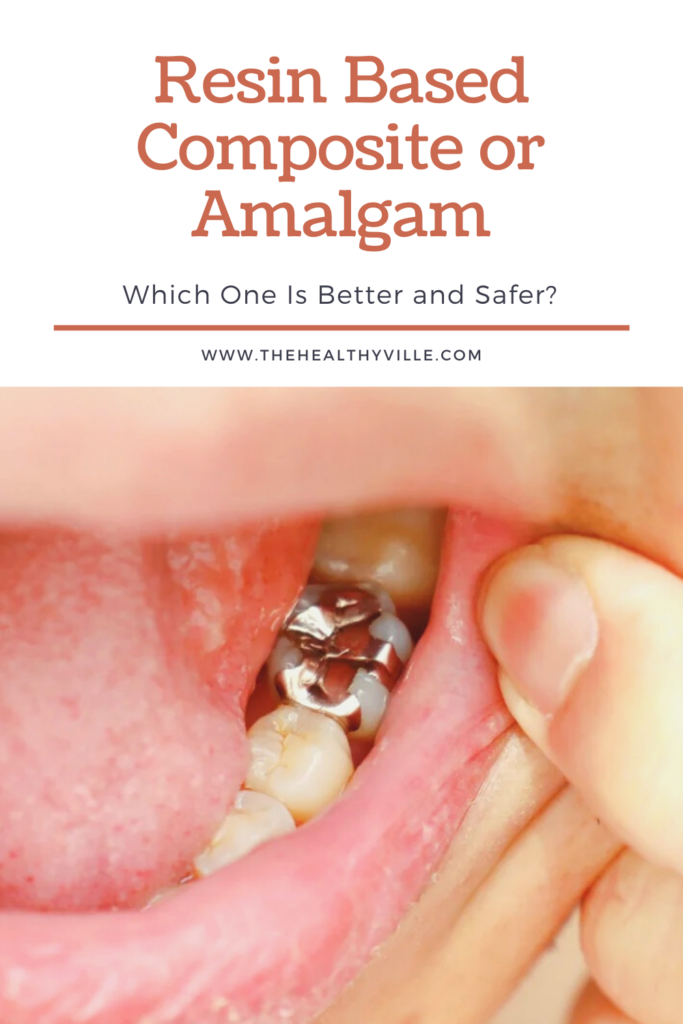Resin based composite and amalgam are different types of materials used to fix teeth. But which one is safer and better?
Both dental resin and amalgam are the most commonly used materials to fill broken teeth. We tell you which is the best alternative.
Suffering from caries implies the need for a treatment that cleans and restores the affected tooth. But when it comes to filling the cavities left by the disease, which is better? A dental resin or an amalgam?
When it comes to repairing broken teeth, the options are very varied. Although most of the time the dentist will resort to amalgams or resins.
Each one has specific characteristics and uses. Its composition, appearance and duration are the most notable differences. Knowing the particularities of each of these materials in detail will allow you to participate in your choice if you need an arrangement.
Keep reading and discover more about these filling options. This way you will be able to understand if dental resin based composite or amalgam is the best option for your case.
Dental fillings
Before delving into the characteristics of dental resin and amalgam, and discovering which is the best option, we will analyze what fillings are.
When suffering from a cavity or suffering a fracture, the dental piece loses part of its tissues. Fillings are the treatments to treat these disorders and restore the anatomy and integrity of the teeth.
Well, a broken dental element not only looks bad, but also affects the functions of speech and chewing. And it retains bacterial plaque, causing cavities to advance and increasing the risk of complications such as pain and infections.
For this reason, fillings are essential to remove diseased tissues and restore function and appearance to teeth. In addition, the materials have to be able to withstand the forces of chewing.
Now that you know what fillings are for, let’s take a closer look at the characteristics of dental resin based composite and amalgam to discover which is the best alternative.
Resin based composite
Composite resins are restorative materials dentists form by combining ceramic and plastic. They are made up of a mixture of reinforced acrylics with a powdered glass filler.
Because their finish mimics the natural appearance of teeth, they have recently gained popularity. Thus, they are not only useful to make fillings, but also veneers, inlays and crowns.
Currently, these resins are light-cured. Well, they harden completely in a matter of seconds when exposed to a beam of halogen light.
Then dentists polish them immediately, being ready at the moment of placing them. This differentiates them from amalgams, which require a few minutes to harden and polish after 24 hours of placement.
They have been used above all in the anterior areas, to restore teeth that can be seen when smiling. It is possible to choose from a wide range of shades to choose the one that most closely resembles your tooth. And thus remain almost imperceptible to the naked eye.
With advances and improvements in dental materials, resins can also be used in the posterior sector. Being able to withstand and resist chewing forces without problems.
The useful life of these plastic materials is around 7 years. After this time it is necessary to assess its condition and control possible wear or leaks.
With good care, resin fillings can be long-lasting. On the contrary, in patients with a high risk of caries, these types of arrangements are not as durable.
Dental fillings are a way of treating cavities, filling the gap produced by the disease.
Advantages of composite resin compared to amalgam
We have already indicated some of the positive aspects of this type of restoration. In any case, below we mention the main advantages of using this material:
- More conservative: when placing this type of restoration, there’s less tooth wear in comparison to amalgam fillings. Therefore, the preparations are much more conservative.
- Aesthetics: they allow the dental pieces to have a natural appearance.
- Finishing in a single visit: dentists finish its placement and polishing in a single visit.
- Dentists use it repair both small and large cavities.
- They do not usually present side effects after being placed. Some patients report short-term temperature sensitivity after the procedure, but nothing more.
- They have a high adherence to dental enamel, making it difficult for them to come off or come off.
Disadvantages of resin based composite
Although composite resins have many advantages, they also have some aspects that are not so positive. As we already mentioned, longevity is one of them.
Regarding the durability of the material, many factors influence the permanence and integrity of the filling. And in this aspect, the amalgam is much more stable and durable over time.
Another negative aspect is the cost. Well, when paying for an arrangement of this type, you will have to have more money than if you choose an amalgam filling.
When used in the posterior sector, they can suffer greater wear and have less resistance to chewing forces. Although with advances in dental materials, this disadvantage occurs only in some patients.
Placement and curing may take longer as the material sets and cures in layers. This can make some more nervous or children impatient. When making these arrangements, it is also necessary that the mouth is very dry.
Dental amalgam
Amalgam is a filling material for dental elements that results from the mixture of mercury with an alloy of metals, mainly silver, tin and copper. This filling is used mainly in the posterior sector. Well, they are able to adequately support the chewing forces and in this area they do not interfere with the aesthetics of the smile.
We know them as silver fillings, since they have a silver appearance. These are shiny silver fillings. In any case, it is the combination of all the metals that make it up that constitutes the arrangement.
To repair a tooth with amalgam, the dentist must remove the cavities and shape the cavity in such a way that it can retain the material. This leads to the need to wear a little more tooth than with a resin.
The dentist mixes the powdered metals with the liquid mercury and forms an amalgam putty. This soft material is placed in the prepared cavity and pressed against its walls, giving it a tooth-like shape. There it hardens rapidly into a solid filler.
Benefits of dental amalgam
Amalgam is a cheaper and more durable filling when compared to resins. With proper care, these fillings can last up to 15 years in the mouth.
In addition, being composed of metals, they have a greater resistance to damage. They are an excellent option to restore severely damaged and destroyed dental pieces. So they are less likely to break.
It is a very useful material in patients with a high risk of caries. They are also a good option in patients or areas where it is difficult to achieve a very dry environment to place resins.
This material hardens quite quickly. For this reason, its use is suitable for children or patients with special needs who cannot stay long with their mouths open.
Disadvantages of amalgam compared to dental resin
One of the main disadvantages of amalgam is its appearance. While many people don’t mind having a silver tooth in their mouth, it is evidence that there was a problem with that tooth. And many patients prefer that when they open their mouths the whole smile is of an even coloration, without signs of past cavities.
In addition, dentists cannot place these types of arrangements in the anterior sector. Well, they are very obvious and no dentist opts for the material.
Over time, amalgam fillings can stain and darken the appearance of the entire restored tooth, giving it a grayish or dull hue that affects the aesthetics of the tooth.
This material can expand and contract with changes in temperature, which could lead to fractures and micro-leakage if not well matched.
In addition, they can cause a phenomenon called galvanic shock. It is a type of dental sensitivity that generates by a discharge similar to an electric one, due to the contact of two metals in an aqueous medium such as the mouth.
Also, some patients may have hypersensitivity to the material. People with allergies to metals may have reactions to an amalgam.
Another disadvantage of this type of material is the presence of mercury in its composition. This has led to amalgam getting a bad reputation as a contaminant and as toxic. We tell you more about it.
Mercury: a controversial component
As we already told you, for the manufacture of the amalgam it is necessary to use mercury. In fact, this element makes up about 50% of the alloy.
Mercury is a heavy metal. For use in dentistry it is used in its elemental form, which is capable of releasing steam. This volatile form is primarily absorbed by the lungs.
This form of mercury is different from the inorganic and organic or methylmercury found in large fish. The digestive system absorbs them.
The problem with mercury is its bioaccumulation. This means that it constantly accumulates in the body’s organs.
And although much of the mercury inhaled, as digested, is eliminated; another part can remain in body fluids and tissues such as the brain and kidneys. Neurotoxic effects are most far-reaching in developing organs, such as those of young children or fetuses.
Evidence
There is insufficient evidence to show that dental amalgam restorations cause bioaccumulation and harm in the body. Even the US Food and Drug Administration (FDA) considers the levels of mercury in these arrangements to be safe.
Thus, dentists do not use them in pregnant women, infants, young children, patients with neurological problems and kidney conditions.
Given this controversy over the toxicity of mercury, many patients wonder if it is necessary to remove the old amalgam fillings and replace them with resins. Given this concern, the FDA does not recommend changing fillings that are in good condition.
Because removing intact amalgam fillings results in unnecessary loss of healthy tooth structure. And it also exposes the person to a temporary increase in mercury vapor during the removal of the fix.
Also, you should know that in some countries there is a prohibition by law for the use of amalgam. The possibility of environmental contamination is the reason why this type of filling is no longer available in all dental offices.
Resin or dental amalgam: which is the best option?
Both resin based composite and amalgam are good restorative materials and recommended for certain situations. It will be the dentist who knows best how to choose the alternative that meets the needs of each case.
Amalgam is durable, resistant and cheap, but they are silver and require more dental wear. Resins, on the other hand, are more aesthetic, their duration is acceptable with the necessary care, there is less tissue damage, but their cost is higher.
In general, when choosing between one or another material, consider the location and size of the arrangement. Dental resin is better for the anterior sector and amalgam for the posterior area. However, thanks to technological advances, dentists choose composites for most fillings, regardless of cavity location.
The dentist will be able to clarify your doubts about the treatment and expose the advantages and disadvantages of each filling material. With the knowledge that we share here, you will be able to talk with your dentist and thus choose together the most appropriate option to restore your mouth.
Don’t forget to SHARE everything about resin based composite and amalgam with your friends and family on your social networks!

